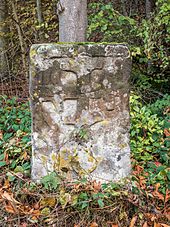Schönaich (Oberschwarzach)
|
Schönaich
Oberschwarzach market
Coordinates: 49 ° 49 ′ 41 ″ N , 10 ° 26 ′ 22 ″ E
|
|
|---|---|
| Height : | 355 m |
| Residents : | 77 (1987) |
| Incorporation : | May 1, 1978 |
| Incorporated into: | Oberschwarzach |
| Postal code : | 97516 |
| Area code : | 09382 |
Schönaich is a village in the district of Upper Schwarzacher hamlet Siegsdorf in the Lower Franconian district of Schweinfurt .
Geographical location
Schönaich is located in the southeast of the municipality. In the north is Breitbach , in the northeast and east begins the municipality of Ebrach in the Bamberg district in Upper Franconia. The district of Groß- und Kleiningressingen is closest to Schönaich. To the south lies the district of Kitzingen with the district of Ebersbrunn in the Geiselwind market . To the southwest, also in the district of Kitzingen, is Altenschönbach , a district of Prichsenstadt . Siegendorf is to the northwest.
history
The place name Schönaich goes back to the conditions of the surrounding area and can probably be interpreted as "to the beautiful oak forest" or "to the beautiful oak ". In the 18th and 19th centuries, the village was the place of activity of the so-called Bory family, who originally came there as plasterers from Italy . As tastes in art changed, the family began to make a living by stealing. Eventually she emigrated to America.
Attractions
The center of the village is the Catholic St. Michael branch chapel . It was built in the 19th century and can be assigned to the neo-Gothic style. There is a small, four-sided bell tower on the roof. In 1965 the neo-Gothic altar was removed and a simple stone canteen was installed. A tapestry depicting the Archangel Michael replaces the altarpiece; it was designed by Gustl Kirchner from Schweinfurt and manufactured in the Olga Pacher workshop. The candlestick came from the Ludwig Boßle workshop.
Two chapels with some neo-Gothic reliefs were built in 1843. The many reliefs that adorn the houses in the village today are typical. Most of them also date from around 1843 and were placed in the gable. Only the two so-called plague crosses from the Middle Ages are much older . There people are said to have died of the plague and legends have started.
literature
- Karl Treutwein : From Abtswind to Zeilitzheim. History, sights, traditions . Volkach 4 1987
